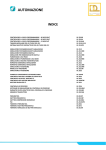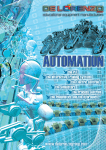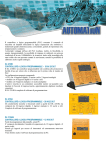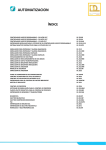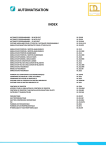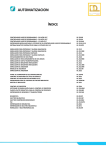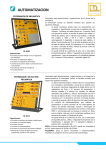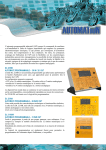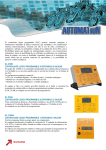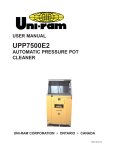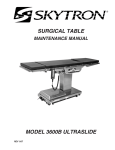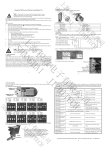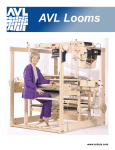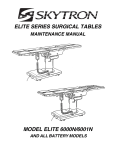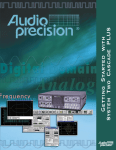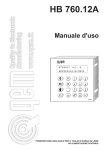Download AUTOMATION - De Lorenzo Group
Transcript
AUTOMATION INDEX PROGRAMMABLE LOGIC CONTROLLER – 36 IN/28 OUT PROGRAMMABLE LOGIC CONTROLLER – 26 IN/22 OUT PROGRAMMABLE LOGIC CONTROLLER – 12 IN/8 OUT PROGRAMMABLE LOGIC CONTROLLERS MODULAR TRAINER INTERACTIVE PLC TRAINER FOR INDUSTRIAL PROCESSES ANALOGUE I/O SIMULATOR ANALOGUE I/O SIMULATOR DIGITAL INPUT SIMULATOR DIGITAL I/O SIMULATOR TWO‐FLOOR PARKING GARAGE SIMULATOR TWO‐ZONE PARKING GARAGE SIMULATOR BELT CONVEYOR SIMULATOR SMART TRAFFIC LIGHTS SIMULATOR SMART TRAFFIC LIGHTS SIMULATOR LIFT SIMULATOR LIFT MODEL LIFT SIMULATOR ELECTROMECHANIC COMPONENT BOARD SQUIRREL CAGE MOTOR CONTROL DC MOTOR SPEED CONTROL BRUSHLESS MOTOR CONTROL TRAINER BRUSLESS DC MOTOR TRAINER PROCESS CONTROL TRAINER PROCESS CONTROL SIMULATION SOFTWARE DIDACTIC PROCESS CONTROL PILOT PLANT SENSORS AND TRANSDUCERS TRAINER PNEUMATICS ELECTRO‐PNEUMATICS SINGLE‐PHASE ELECTRO‐COMPRESSOR PLC PNEUMATIC TRAINER ELECTRO‐PNEUMATIC TRAINER HYDRAULICS AND ELECTRO‐HYDRAULICS DL 2210B DL 2210A DL 2110AH DL 2110‐131K DL 2110ITS DL 2112 DL 2112RM DL 2113 DL 2113RM DL 2120 DL 2120RM DL 2124 DL 2121 DL 2121RM DL 2122RM DL 2122M DL 2122 DL 2104G DL 2123 DL 2125 DL 2108T26 DL 2131 DL 2314 DL 2314SIM DL 2314BR DL 2312HG DL 8110P DL 8115EP DL 8110SLZ DL 2110ATN DL 8161 DL 8171 DL 8110H AUTOMATION The programmable logic controller (PLC) allows controlling machines and installations by using the sequential logic that replaces the traditional electromechanical boards, allowing, therefore, to save relays, timers and counters. Moreover, the main advantages in the use of the PLC are the flexibility, because they can be re‐programmed, the industrial characteristics, thanks to the possibility of their use in environments with heavy working conditions, the reliability and the safety, typical of the solid state technology that has no moving contacts, as well as the possibility to process analogue signals. PROGRAMMABLE LOGIC CONTROLLER – 36 IN/28 OUT The DL 2210B unit is a programmable controller that combines high performances and ease of use for those who are approaching for the first time the world of PLC. The proposed configuration includes: • CPU with 14 digital inputs, 10 relay outputs and 2 analogue inputs • module with 16 digital inputs and 16 relay outputs • module with 4 analogue inputs and 2 analogue outputs The unit is fitted in an accessible container while on the panel the input/output terminals are shown, suitably duplicated by means of connectors. The DL 2210B is complete with the programming software. DL 2210B PROGRAMMABLE LOGIC CONTROLLER – 26 IN/22 OUT This unit has technical and functional characteristics similar to the ones of the DL 2210B, but it is composed of a CPU with 24 digital inputs, 2 analogue inputs and 22 relay outputs. Complete with the programming software. DL 2210A PROGRAMMABLE LOGIC CONTROLLER – 12 IN/8 OUT DL 2110AH Easy to be programmed from its own panel, without computer. It is composed (including the extension module) of 12 digital inputs and 8 relay outputs. Simulation of the inputs through switches and externally through terminals. The programming software is also supplied to allow programming the PLC from the computer, if so preferred. AUTOMATION PROGRAMMABLE LOGIC CONTROLLERS MODULAR TRAINER DL 2110‐131K This modular trainer allows the study of the PLC. The aluminium frame has 4 lines for manual and fast fixation of the modules without the need for tools. Each isolated panel contains 2 or 4 mm. terminals for easy connection. The components, as well as their terminals and access points, are identified with the respective symbol on the front panel diagrams. • PLC module: a Programmable Logic Controller with integrated Man‐ Machine Interface (MMI) and liquid crystal display. It includes the programming software. Configuration: 8 transistor digital inputs (24 Vdc), 8 transistor digital outputs (24 Vdc), 4 analogue inputs (0‐10 Vdc), 2 analogue outputs (0‐10 Vdc), 1 pulse fast counting input (4 kHz). All of the inputs and outputs are accessible through 2 mm. terminals and identified with symbol on the front panel diagram. • Input power module, with protection switch and lights. Power supply: single‐phase from mains. • Power supply module with polarity inversion and over‐current protection. Outputs: 12 Vdc, 24 Vdc and 0 ÷ 24 Vdc. • Module with switches for digital input signals simulation. It includes 8 fixed contact switches with retention, NC/NO, for simulating the logic levels. • Module with switches for digital input signals simulation. It includes 8 contact pulse switches, NC/NO. • Module with switches for digital input signals simulation. It includes 4 contact pulse switches, NC/NO and 4 contact retention switches, NC/NO. • Module with 8 led for light indication of output digital signals, suitable for PLC with NPN or PNP outputs. • Module with 2 linear potentiometers for simulation of voltage or current signals (4 to 20 mA and 0 to 10 Vdc). • Module for analogue signals measurement. Possibility to measure 2 signals simultaneously. One of the inputs is suitable for current signals from 4 to 20 mA and the other for voltage signals from 0 to 10 Vdc. • Module with step motor, with 4 bit electronic driver, with light indication for each bit. • Module with 4 relays for 10 A and 24 Vdc coil, suitable for PLC with NPN or PNP outputs. • Module with DC motor and encoder, suitable for PLC with NPN or PNP inputs. • Module with Analogue/Digital converter, with analogue signals input from 0 to 10 Vdc / 4 to 20 mA and 4 bit outputs 24 Vdc. • Module for Digital/Analogue converter, with 4 bit inputs 24Vdc, analogue output signals adjustable from 0 to 10 Vdc and from 4 to 20 mA. Supplied with a set of 30 connection cables, 2 and 4 mm, and an experiment manual. AUTOMATION INTERACTIVE PLC TRAINER FOR INDUSTRIAL PROCESSES DL 2110ITS‐1200 DL 2110ITS‐300 SIMATIC S7‐1200 CPU 1212C AC/DC/Relay Additional SM 1223 16 digital inputs 14 relay outputs 2 analogue inputs 85 … 264 Vac – 50/60 Hz PS 24Vdc/2.7A Ethernet STEP 7 Basic DL 2110ITS‐1200 SIMATIC S7‐300 CPU 312C DC/DC/DC Additional SM 323 18 digital inputs 14 transistor outputs 120/230 Vac – 50/60 Hz PS 24Vdc/2A USB (PC Adapter – MPI/DP) Micro Memory Card STEP 7 Professional DL 2110ITS‐300 The DL 2110ITS is a training tool for PLC programming, that uses a PLC SIEMENS (SIMATIC S7‐1200 or S7‐300 series) and an interactive educational software for the simulation of industrial environments to be controlled. HOW DOES IT WORK? The DL 2110ITS offers five virtual industrial processes to learn how to program a PLC, with real situations of sorting, batching, palletizing, pick and place and automatic warehousing. Each process reproduces the visual simulation of an industrial situation, including virtual sensors and actuators, so that the state of the system is “sensed” and controlled by the PLC: the objective is to program the PLC to control each of the five virtual processes as if they were real systems. The information is exchanged between the PLC and the virtual system through a data acquisition board (DAQ) provided with 32 I/O isolated channels and USB interface. MAIN FEATURES • PLC Siemens of the SIMATIC S7‐1200 or S7‐300 series • 3D realistic graphics • Real‐time physics that closely emulates what happens in real life • 3D real‐time sound • Total interactivity with the systems • Friendly user interface • Easy and fast to setup Based on the latest PC technology, the DL 2110ITS makes PLC training easy and fun. Virtual environments have never been so real, featuring cutting‐edge 3D real‐time graphics, sound and total interactivity. The result is an immersive simulated environment that allows highly realistic training processes, without any risk of injury to man or damage to machines. The automation tasks are presented with increasing levels of difficulty, so that users can progress to more advanced exercises as they improve their skill. The DL 2110ITS presents five training processes based on real world industrial scenarios. Each process offers standard problems found in PLC programming, presented in order of increasing level of difficulty. DESCRIPTION OF THE PROCESSES SORTING: transport cases from the entry bay to the elevators, sorting them by height BATCHING: mix three primary colors (red, green and blue) in order to obtain a desired color PALLETIZER: palletize cases up to three layers PICK & PLACE: place parts inside boxes through a three axes manipulator AUTOMATIC WAREHOUSE: transport, store and retrieve boxes from a rack FAULT SIMULATION The DL 2110ITS allows you to simulate failures in sensors and actuators. These failures can be in open circuit or short‐circuit. With this feature the user is able to induce malfunctions in the system, presenting new challenges and increasing the realism of the simulation. INTERACTIVITY • Interact with the system as you would in a real system • Add and remove objects from the production circuit, at any time during the simulation • Cause error situations or system jams • Test individual parts of the system; for example: test a conveyor table AUTOMATION ANALOGUE I/O SIMULATOR DL 2112 ANALOGUE I/O SIMULATOR DL 2112RM It includes 1+1 inputs, at 4‐20 mA and 0‐10 V respectively, and 1+1 outputs at 4‐20 mA/0‐5 V, smoothly variable through potentiometer; the current/voltage display is of digital type. The connection to the PLC can be carried out through terminals. Power supply: single‐phase from mains. Complete with connecting cables, educational manual and software. NOTE: It can be connected to a PLC such as the DL 2210B. DIGITAL INPUT SIMULATOR DL 2113 DIGITAL I/O SIMULATOR DL 2113RM The simulator is essential and indispensable for operation and understanding of the analogue modules of the PLC. The board includes 2+2 inputs, at 4‐20 mA and 0‐10 V respectively, and 4 outputs at 4‐20 mA/0/1‐5 V, smoothly variable through potentiometer; the current/ voltage display is of digital type; the input indication is of bar type, through meters that can be switched. Moreover, 4 outputs at 24 Vdc/1 A are available, internally powered. The connection to the PLC can be carried out through terminals or connector. Power supply: single‐phase from mains. Complete with connecting cables, educational manual and software. NOTE: It can be connected to a PLC such as the DL 2210B. The simulator allows studying and analyzing the programming techniques through automatisms which are freely and imaginatively implemented. Moreover, it allows the PLC potentialities to be pointed out. The board includes 32 switches on 4 columns for PLC input enabling, with a LED signaling the on/off state of the individual switch and the possibility of marking the references on special tags that can be cancelled; moreover, 4 outputs at 24 Vdc/1 A are available, internally powered. The connection to the PLC can be carried out through terminals or connector. Power supply: single‐phase from mains. Complete with connecting cables, educational manual and software. NOTE: It can be connected to a PLC such as the DL 2210A or DL 2210B. It includes 8 switches for PLC input and 8 LED for PLC output. The connection to the PLC can be carried out through terminals. Power supply: single‐phase from mains. Complete with connecting cables, educational manual and software. NOTE: It can be connected to a PLC such as the DL 2110AH. AUTOMATION TWO‐FLOOR PARKING GARAGE SIMULATOR DL 2120 The system represents a two‐storey parking garage where it is possible to realistically simulate all the sequences that a car driver has to perform when he wants to use an automated parking garage. The automatic control is performed through a PLC, whose program manages the displays signaling vacant and full places, both at the entrance and at every floor, the opening and closing of the in and out barriers, the lighting intensity at each floor, regulated by the presence of at least one car detected by special sensors, and the smoke and fire detectors. The number of cars in the parking garage is displayed through LED, whose control is assigned to an electronic circuit separated from the PLC. Complete with connecting cables, educational manual and software. Power supply: single‐phase from mains. NOTE: It can be connected to a PLC such as the DL 2210A or the DL 2210B. TWO‐ZONE PARKING GARAGE SIMULATOR DL 2120RM It represents a two‐zone parking garage where it is possible to realistically simulate the sequences that a car driver has to perform when he wants to use an automated parking garage. The automatic control is performed through a PLC, whose program manages the displays signaling vacant and full places for both zones and the opening and closing of the in and out barriers. The number of cars in the parking garage is displayed through LED. Complete with connecting cables, educational manual and software. Power supply: single‐phase from mains. NOTE: It can be connected to a PLC such as the DL 2110AH. BELT CONVEYOR SIMULATOR DL 2124 The board allows simulating the transfer of material. The system of rolls used for the transport, the loading and the accumulation of material are simulated by means of LED. Test signals are available, such as: • wrong programming indicator • limit switch closing indicator • optical‐acoustic indicator for alarms • motor overload indicator Besides the automatic control carried out through the PLC, it is possible to manually carry out all the operations. The system is complete with educational manual. Power supply: single‐phase from mains. NOTE: It can be connected to a PLC such as the DL 2210A or the DL 2210B. AUTOMATION SMART TRAFFIC LIGHTS SIMULATOR This system represents a crossing between two one‐way streets, each controlled by a semaphore and provided with three pedestrian crossings with semaphores, too. The automatic control of the semaphore system is performed through PLC not with the normal cyclic timing: only the presence of at least one car determines the green signal of the relevant semaphore, allowing the transit of all the cars between the two detecting sensors. The dialogue between the semaphores of the two roads allows the alternation of the green signal as a function of the traffic intensity, while the pedestrian crossing is on request. The present cars are displayed through LED, whose control is assigned to an electronic circuit separated from the PLC. Complete with connecting cables, educational manual and software. Power supply: single‐phase from mains. NOTE: It can be connected to a PLC such as the DL 2210A or the DL 2210B. DL 2121 It represents a crossing between two streets, each controlled by a semaphore with a pedestrian crossing, also controlled by a semaphore. The automatic control of the semaphore system is performed through PLC, as a function of the arrival of the cars or of the call by a pedestrian. All the above situations are simulated through pushbuttons. NOTE: It can be connected to a PLC such as the DL 2110AH. SMART TRAFFIC LIGHTS SIMULATOR DL 2121RM It simulates a three‐stop lift with real processing procedures. Lift car up‐ down manual cycle with automatic PLC control and management. The lift car motion is displayed by LED. Booking obtained through buttons, on priority basis and independently from the lift car position. Lift car door open indication. Upper and lower limit switches to avoid programming mistakes. Connection to PLC through terminals. Power supply: single‐phase from mains. Complete with connecting cables, educational manual and control software. NOTE: It can be connected to a PLC such as the DL 2110AH. LIFT SIMULATOR DL 2122RM AUTOMATION LIFT MODEL The model consists of a real three‐stop scaled down lift and allows an innovative approach to PLC control and management. The model includes: • lift car up‐down and position visual signaling at each floor • photocell on the lift car door to stop its closing in presence of an obstacle • booking to be effected through buttons with flashing signaling, on priority basis and independently from the lift car position • lift car geared motor, hoist and electromagnetic brake • floor, safety and lift car deceleration limit switches • lift car and floor door open‐shut motors • motor protection thermal relays simulated by buttons • lift car deceleration, either up and down, near the stop floor • reproduction of the inside lift car switch panel • installation graph on the panel • connection to PLC through terminals or connectors • fault simulator through micro‐switches Power supply: single‐phase from mains. Complete with connecting cables, educational manual and control software. NOTE: It can be connected to a PLC such as the DL 2210B, although it is possible to use also a DL 2210A, but without booking visual signaling on the lift car switch panel. DL 2122M LIFT SIMULATOR DL 2122 The simulation board is a three‐stop lift with real processing procedures. Lift car up‐down manual cycle with automatic PLC control and management. The lift car motion is displayed by LED bar‐graph while the floor and safety limit switches are displayed by LED. Booking to be effected through buttons with fl ash signaling, on priority basis and independently from the lift car position. Lift car and floor door open‐shut button simulators. Motor thermal relay button simulator. LED signaling for the activation of the electromagnetic brake of the lift car motor and for floor door opening. Reproduction of the inside lift car switch panel: booking by lighting buttons, STOP and ALARM buttons. At each floor and on the lift car panel the lift car position and the up‐down indication are displayed by LED. Fault simulator by micro‐switches. Connection to PLC through terminals or connectors. Power supply: single‐phase from mains. Complete with connecting cables, educational manual and control software. NOTE: It can be connected to a PLC such as the DL 2210A or the DL 2210B. AUTOMATION ELECTROMECHANIC COMPONENT BOARD DL 2104G SQUIRREL CAGE MOTOR CONTROL The board allows performing the most important experiments in industrial electrical plants. The components are connected to the board front panel through 2 mm terminals for what concerns the low voltage controls and through 4 mm safety terminals for the connections to the mains. All the components are identified through a clear synoptic diagram showing their type and symbol. The board includes: • 1 power supply, 24 V • 1 bipolar switch, 1 ‐ 0 ‐ 2 • 1 thermal relay • 2 timers • 5 push‐buttons • 5 signaling lamps • 5 remotely controlled switches with relevant auxiliary contacts On the back side of the board there are switches to allow for the introduction of faults by the teacher. The board is complete with a kit of connecting leads. Power supply: single‐phase from mains. NOTE: It can be connected to a PLC such as the DL 2210A or DL 2210B. Accessories: the electromechanical component board can be used together with a Dahlander motor, such as DL 2102D, or a squirrel cage motor, such as DL 10115AV. The board, allowing the simulation of starting systems for the motors with squirrel cage rotor, is equipped with a clear synoptic diagram that shows through terminals: the push‐buttons, the thermal relay contacts, the contactor coils and the signaling lamps. The system, besides the board, includes a three‐phase asynchronous motor supplied at the reduced voltage of 42 V, complete with educational base and terminals that make easy the connection to the simulation panel. The speed meter, connected to an opto‐encoder, allows measuring the rotation speed of the motor. Besides, a magneto‐thermal switch and an emergency key allow the immediate interruption of the supply circuit in case of overload or short‐ circuit. With this system, the student will be able to study the following: • Telestarting of three‐phase asynchronous motor • Running teleinversion • Star‐delta telestarting • Bias teleswitch • Star‐delta telestarting with running teleinversion • Bias teleswitch for two speed motor of Dahlander connection. The checking and the automatic management are carried out by means of PLC. Complete with educational manual. Power supply: single‐phase from mains. NOTE: It can be connected to a PLC such as the DL 2210A or the DL 2210B. DL 2123 AUTOMATION DC MOTOR SPEED CONTROL The system has been designed for the study of programmable logic control techniques in the control of the speed of a separately excited dc motor. The speed regulation includes two control loops: hardware current loop with overcurrent limiting and speed loop with external PLC control. Speed measuring with a tacho generator or with an opto‐encoder via frequency/voltage converter. Speed reference set by means of potentiometer or selector switches and under PLC control. The PI controller modulates the PWM circuit that drives the power stage consisting of switching transistor. Possibility of acceleration and deceleration ramps programming. Pointer meters for motor speed, voltage and armature current; connection to PLC through terminals or connectors. The system is supplied with a machine set consisting of a dc permanent magnet motor, a dc tacho generator, an encoder and a manual shoe brake. Power: 48 Vdc, 5 A. Tachometric signal: 180 V at 3000 rpm. Power supply: single‐phase from mains. Complete with connecting cables, teacher’s manual and student’s work forms. With this system, the student will be able to study the following: • Open loop speed control • Closed loop speed control • Use of the PLC for the speed measuring • Acceleration and deceleration ramps programming • Duty cycle monitoring NOTE: It can be connected to a PLC such as the DL 2210B. DL 2125 AUTOMATION BRUSHLESS MOTOR CONTROL TRAINER Study of automatic control for a brushless motor: control and operation of a brushless motor in voltage. The system allows the study of the operation of a brushless motor of a typical industrial process automation. The student has the opportunity to learn to control and parameterize an automatic operation. The control and monitoring system is done through a software that can: • Set system parameters • Draw graphic curves • Monitor in real‐time the system (torque, speed, etc.) Technical Specifications 1kW power brushless motor with electronic encoder Control of the system in frequency and voltage Encoder outputs for the analysis of speed Display system for controlling and monitoring events Button start and stop action and automatic stop intervention in case of alarm Complete software for PC interfaced to the system via RS485. Suggested accessories: Base (DL 1013A) Electromagnetic brake (DL 1019M) Power supply for the brake (DL 1054) DL 2108T26 AUTOMATION BRUSLESS DC MOTOR TRAINER DL 2131 This product is a complete didactic system for the study of 3 disciplines (DC brushless motor, PLC and Human Machine Interface HMI), important in both industrial and civil sectors. It has been developed as an “open” system; each hardware component is independent from the other ones, allowing the study of each system in autonomous way, connecting other existing equipment of the laboratory. Technical Specifications • Brushless DC motor o Ideal for handling and positioning applications o Variable speed control (PWM) with 4‐quadrants o Power supply: 24Vdc o Speed and Current (no load): 4200rpm/0.4A o Speed/torque/current (with load): 3250rpm/0.24Nm/4.8A o Output type: PNP/50mA • PLC o LCD display with 4 lines of 18 characters o Power supply: 24Vdc o Inputs: 16 digital (of which 6 can also be analog) o Outputs: 10 solid states/0.5A (of which 4 can also be PWM) o Equipped with multilingual programming software with special functions (Ladder/FBD) o 3 operating modes for programming with complete reliability (Editing, Simulation and Monitoring) • HMI o Display type: TFT LCD o Display size (diagonal): 4.3” o Max Colors: 65536 o Resolution: 480x272 o Touch screen: 4‐wire, analog resistive o CPU and core logic: 32Bit RISC 400MHz processor o DRAM: 64MB DDR2 on board o I/O: 1 serial port COM1 RS485 and 1 Ethernet Port (10/100 Base‐T) o Power supply: 24Vdc o Software: EB8000 with multilingual programming AUTOMATION PROCESS CONTROL TRAINER The trainer is composed of: • an educational board with a pressurized vessel and a set of sensors and actuators for level, pressure, temperature and flow; • a control module, containing the interface circuits for the sensors and the actuators and the ON/OFF, proportional, integral and derivative control circuits (PID). TECHNICAL FEATURES Pressurized vessel capacity: 5 litres approx. Water tank capacity: 20 litres approx. Temperature sensors: • platinum thermo‐resistance Pt 100 • bi‐metallic direct reading thermometer Level sensors: • linear variable‐differential transformer (LVDT) • on‐reed ON/OFF sensor Flux sensors: • flowmeter 8000 pulses/ litre • flowmeter, direct reading Pressure sensors: • strain gauge • manometer, direct reading Recirculation pump: 6 litres/minute, 12 V, 1.5 A Motor driven valve 4 manual valves Water heating resistance: 48V, 200W Safety valve set at 2.4 bar Safety thermostat Piping: brass Power supply: single‐phase from mains With this system, the student will be able to study the following: • Study of the level, flow, pressure and temperature sensors • Study of the characteristics of the pump and of the motor pump • Study of the characteristics of the static process and of the time constants • ON‐OFF, P, PI, PD and PID closed loop control of the level • P, PI, PD and PID closed loop control of the flow • ON‐OFF, P, PI, PD and PID closed loop control of the temperature • ON‐OFF control of the level with the pressure sensor Optionally, it is possible to connect to the trainer: • a microprocessor based process controller of industrial type (DL 2314C) • a process recorder (DL 2314R) • a programmable logic controller (DL 2210B) • a personal computer with suitable interface module and software (PC with DL 1893 and DL 2314SW) DL 2314 AUTOMATION PROCESS CONTROL SIMULATION SOFTWARE DL 2314SIM Simulation software in LabVIEW environment. The simulator is composed of two parts: the controller and the system to be controlled. Controller The user can influence the behaviour of the system through the controller. The system is controlled by the following parameters of the actuators: • Pump: input voltage (0V to 10V) • Motor driven pump: angle (0° to 40°) • Heating resistance: input voltage (0V to 10V) and in the process tank: • Manual output valve 1: angle (0° to 90°) • Manual output valve 2: number of rpm • Solenoid valve: on or off • Air valve: on or off The controller is composed of PID and On/Off controls that are used to control the temperature of the water, its pressure and its level inside the process tank. The parameters can also be manually controlled. System to be controlled The system is composed of a didactic plant that consists in a pressurized process tank, a storage tank and a set of sensor and actuators for level, pressure, temperature and flow. The behaviour of the system is modeled on the basis of the characteristics of the physical components. Under a given supply voltage, the pump creates a flow of water that also depends on the pressure in the system. In the process tank some amount of water may be stored and exert a hydrostatic pressure at the bottom. The process tank is also equipped with an air valve that can be used to control the pressure of the air inside the tank. The output pressure from the tank is, therefore, the sum of the hydrostatic pressure and of the air pressure. The temperature of the water inside the process tank can be controlled by means of a heating resistance. To influence the pressure in the system also the valves may be used. The storage tank is used to store water for the system and there is atmospheric pressure at its output. The simulator calculates and presents to the user the following parameters: • Flow in the system • Outflow from the process tank • Pressure exerted on the pump • Total pressure at the output of the tank • Level of the water in the process tank • Temperature of the water in the process tank AUTOMATION DIDACTIC PROCESS CONTROL PILOT PLANT TECHNICAL FEATURES • Vessel capacity: 120 liters • Recirculation pump with 20 to 50 liters/min • Temperature sensor type PT100 with intelligent transmitter • Different types of level sensors • Diaphragm type pressure sensor regulated at 500 mmH2O • Rotameter type flow sensor REQUIREMENTS • Input power: three‐phase • Compressed Air: 6Kgf/cm2 • Water input and output connections • PC station with Windows operating system This pilot plant allows the study of the continuous process control, based on the typical four variables, that is, Pressure, Temperature, Flow and Level. This plant is made of real industrial and commercial components, easily identified by the student and commonly utilized in industrial plants. Besides the indicators and sensors, the plant includes transmitters that convert the physical signals to electric signals, to be processed by the PLC and/or the PID controllers. Additionally, the plant has a terminal bus, where all the electrical signals are available for an external controller. This plant is basically composed of: • The main aluminum structure with rollers for easy moving. Dimensions: 2400x800x1700 mm. • The control panel with PLC and all the electric components for plant control and study • Two pressurized vessels (one made in Acrylic and another made in stainless steel) • A centrifugal recirculation pump controlled by a frequency inverter that is on the PID network • A heater and heat interchanger • Temperature, pressure, flow and level sensors • Directional valves • Electrical power controller • A PID controller DL 2314BR AUTOMATION SENSORS AND TRANSDUCERS This sensors and transducers trainer teaches the operating principles of the sensors/transducers which are most widely used in industry. It is TRAINER subdivided in two sections: in the lower section there are all the input and output transducers, while in the upper side there are all the signal conditioning systems as well as the instrumentation. With this system, the student will be able to study the following: • Survey on the features of a position control system • Features of a speed control system • Application of the timer/counter as time meter • Application of the timer/counter as tachometer or frequency meter • Features of a visualization unit with graphic LED bar • Features of a meter with mobile coil • The buffer as compensator of the load effect of an output voltage in the potentiometer • Servo‐potentiometer. Variation of the output voltage on the basis of its position • Resistance measurement through a Wheatstone bridge • Voltage measurement through null balance (two methods) • Temperature features through integrated circuit LM 35 • Features of: a platinum transducer with resistor on the basis of temperature (RTD), a thermistor N.T.C., a thermistor using an alarm DL 2312HG circuit (double thermistor), a thermocouple type “K”, a photovoltaic cell, a phototransistor, a detector of light intensity, a variable resistor, a flux meter, a pressure detector, an optoelectronic transducer with application for counting and speed measurement, a reflective opto transducer and the grey code disk, an inductive transducer, a Hall effect transducer, a tacho generator with dc permanent magnet, a dynamic microphone, an ultrasonic receptor, a loudspeaker coil, a buzzer, a dc solenoid, a dc relay, a permanent magnet motor, a dc current amplifier, a current amplifier and buffer amplifier application, a power amplifier and buffer, a differential amplifier, a V/I converter, a I/V converter, a V/F converter, a F/V converter, a full wave rectifier, a comparator, an alarm oscillator circuit, an electronic switch, an adder amplifier, an integrator amplifier, a differential amplifier, a Sample and Hold circuit, a humidity sensor. THE TRAINER INCLUDES THE FOLLOWING INPUT SENSORS/TRANSDUCERS: linear slide potentiometer, rotary potentiometer, precision servo potentiometer, Wheatstone bridge circuit, thermistors NTC, RTD platinum sensor, IC temperature sensor, thermocouple, phototransistor, PIN photodiode, photoconductive cell, photovoltaic cell, LVDT, extensiometric transducer, linear position sensor, air flow sensor, air pressure sensor, humidity sensor, opto‐electronic sensor, opto‐reflecting sensor, inductive sensor, Hall effect sensor, dc tacho generator, microphone; THE FOLLOWING OUTPUT SENSORS/TRANSDUCERS: electric resistance, incandescent lamp, buzzer, moving coil loudspeaker, ultrasonic transmitter, ultrasonic receiver, dc solenoid, dc relay, dc motor; AND THE FOLLOWING SIGNAL CONDITIONING COMPONENTS: timer/counter, bar graphs, dc voltmeter, dc amplifiers, ac amplifiers, power amplifiers, current amplifiers, buffer amplifier, inverting amplifier, differential amplifier, V/F converter, F/V converter, I/V converter, V/I converter, complete wave rectifier, hysteresis switchable comparator, alarm oscillator, electronic switch, oscillator, filter, switchable low‐pas filter, power supply, adding amplifier, integrator with switchable time constant, instrumentation amplifier, sample & hold circuit, gain and off set control amplifier. AUTOMATION Through our trainers, students have the possibility of studying a collection of main components, for a better understanding of pneumatics and electro‐pneumatics techniques. A modular system provides teachers with the best tool for developing training courses related to both logics and pneumatics/electro pneumatics control techniques. It is a flexible system composed of a vertical frame where the modules are easily inserted for the execution and/or the demonstration of the pneumatic circuits; it also allows obtaining several sequential cycles, by following standard techniques and procedures. Pneumatic connections are performed by means of pipes and fast release joints; electric connections are through 2 mm. cables, since the electric devices and components (sensors, coils, relays, etc.) need a low power consumption and, therefore, the supply voltage can be low and safe (24Vdc). The standard symbols of the different components are clearly shown on the modules, to facilitate the connection of both the air pipes and the electric cables, besides explaining the function of each component. PNEUMATICS DL 8110P This trainer is composed as follows: BASIC MODULES DL 8110P01: Slide valve, filter‐regulator with manometer and distributor DL 8110P02: Hand operated 3/2 NC minivalve and 5/2 NC‐NO minivalve, flat push‐button DL 8110P03: Hand operated 3/2 NC minivalve, flat push‐button, and 5/2 NC‐NO minivalve with selector DL 8110P04: Hand operated 3/2 NC minivalves, flat and mushroom head push‐button DL 8110P05: Pressure visualizers and one‐way flow micro‐regulator DL 8110P06: Manometers and two‐way flow micro‐regulator DL 8110P07: 3/2 pneumatic valves, NC (YES) and NO (NOT), with mechanical spring and filters DL 8110P08: 5/2 pneumatic valves, monostable (2) and bistable (2) with filters DL 8110P09: Valves AND (2) and OR (2) DL 8110P10: Timer (NO and NC) and silenced quick exhaust valve DL 8110P11: Simple effect (SE) magnetic cylinder with retracted piston rod and flow micro‐regulator DL 8110P12: Double effect (DE) magnetic cylinder with flow micro‐ regulators (2) and roller lever minivalves DL 8110P13: Double effect (DE) magnetic cylinder with flow micro‐ regulators (2) and unidirectional and bidirectional roller lever minivalves ADVANCED MODULES DL 8110P14: 5/3 pneumatic valves with closed centers (1) and pressure centers (1) mechanical springs, both with filters DL 8110P15: 4 digit pneumatic pulse counter with reset DL 8110P16: Pneumatic amplifier with positive output DL 8110P17: Double effect (DE) cylinder with flow micro‐regulators and weight (to be pulled or pushed according to its position) DL 8110P18: Pneumatic 4‐module sequencer AUTOMATION ELECTRO‐PNEUMATICS DL 8115EP SINGLE‐PHASE ELECTRO‐ COMPRESSOR DL 8110SLZ With very low noise level for small capacity. Tank capacity: 24 litres Air intake: 50 litres/min. Max. working pressure: 8 bar or 116 PSI Motor power: 0.34 kW or 0.45 HP Noise level: 40 dB Dimensions: 40 x 40 x 60 (h) cm. Weight: 25 kg. This trainer is composed as follows: BASIC MODULES DL 8110P01: Slide valve, filter‐regulator with manometer and distributor DL 8110P11: Simple effect (SE) magnetic cylinder with retracted piston rod and flow micro‐regulator DL 8115EP01: 3/2 electro‐pneumatic valves, 1 NC (YES) and 1 NO (NOT) DL 8115EP02: 5/2 electro‐pneumatic valves, bistable (1) and monostable with mechanical spring (1) with filters DL 8115EP03: Double effect (DE) magnetic cylinder with flow micro regulators (2), reed sensors (2) and photo‐electric sensor DL 8115EP04: Double effect (DE) magnetic cylinder with flow micro regulators (2), reed sensors (2), inductive sensor and capacitive sensor DL 8115EP05: Stabilized power supply module: 24Vdc, 2A DL 8115EP06: Module with 6 push‐buttons (with 1 NO contact, 1 NC contact each) DL 8115EP07: Module with 3 relays (with 4 NO contacts, 4 NC contacts each) DL 8115EP08: Module with 4 lamps, 2 timers (on‐delay and off‐ delay) and two switches, 1 NO contact, 1 NC contact each ADVANCED MODULES DL 8110P06: Manometers and two‐way flow micro‐regulator DL 8115EP09: Pressostats, adjustable (1) and pressure controlled (1), 1 NO contact, 1 NC contact each DL 8115EP12: Proportional electronic regulator and digital pressostat NOTE: the electro‐pneumatic bench DL 8115EP can be connected to a PLC, such as the DL 2110ATN. ACCESSORY: the pneumatic and electro‐pneumatic benches need an air compressor such as: 8110SLZ. PLC With 8 digital inputs, 6 relay outputs, 2 analogue inputs and 2 analogue outputs, panel type. It can be assembled on a De Lorenzo frame. Complete with the programming software. DL 2110ATN AUTOMATION PNEUMATIC TRAINER DL 8161 Experiments • Single cylinder circuits with or without speed regulation • Circuits with logic devices • Circuits with delay devices • Single or continuous sequence control of two or more cylinders • Circuits with emergency control • Memory circuits Trainers for demonstrations and experiments in the pneumatic field. The trainer includes a metal frame supporting the following modules: ‐ A pneumatic board, where all the components are mounted and identified through a clear symbol. They include: 2 double‐acting cylinders with 3 return orifice check valves, 4 roller lever and 1 lever 3/2 valves, 2 stable and 2 unstable 5/2 valves, 2 AND, 2 OR and 1 NOT, 1 throttle valve, 1 capacity, 1 fast relief valve and 1 splitter. Supplied with 75 m of ø4 and 3 m of ø6 plastic tube, 10 tees and 10 plugs, as well as 1 pipe cutter, service manual and exercise book with experiments. ‐ An air supply vertical board, providing 1 lever main switch, 1 filter, 2 pressure regulators with 2 pressure gauges, 1 mushroom and 3 digital 3/2 push‐buttons, 1 lever 5/2 selector and 1 digital 5/2 push‐button. ELECTRO‐PNEUMATIC TRAINER DL 8171 Experiments • Circuits with single and double‐acting cylinders • Circuits with logic controls • Circuits with relays • Circuits with timers • Circuits with multiple cylinder sequences • Driving of circuits with programmed logic sequence, using an optional PLC Trainers for demonstrations and experiments in the electro‐ pneumatic field. The trainer includes a metal frame supporting the following modules: ‐ A pneumatic board, where all the components are mounted and identified through a clear symbol. They include: 6 magnetic doub1e‐acting cylinders with 12 flow regulators and 12 proximity sensors, 4 stable and 2 unstable 5/2 valves, 10 unstable 2/2 solenoid valves and 1 splitter. Supplied with 50 m of ø4 and 3 m of ø6 plastic tube, 1 tee and 5 plugs, as well as 1 pipe cutter, service manual and exercise book with experiments. ‐ An electro‐pneumatic board, that, in addition to providing the terminal board for limit switches and valve solenoids, includes: 1 emergency and 4 control push‐buttons, 1‐2PDT switch, 1 delayed pickup and 1 delayed drop‐out time relay, 5 auxiliary contactors with 6 changeover contacts each and 3 signal lamps. ‐ An air supply vertical board, providing 1 lever main switch, 1 filter, 2 pressure regulators with 2 pressure gauges, 1 mushroom and 3 digital 3/2 push‐buttons, 1 lever 5/2 selector and 1 digital 5/2 push‐button. NOTE: the electro‐pneumatic bench DL 8171 can be connected to a PLC, such as our DL 2210A or DL 2210B. ACCESSORY: both the pneumatic and electro‐pneumatic benches need an air compressor such as our DL 8110SLZ. AUTOMATION HYDRAULICS DL 8110H THIS TRAINER IS COMPOSED AS FOLLOWS: • Work bench complete with metal working panel with holes for clamping the hydraulic components without using additional tools, 4 wheels and 3 drawers for storing components. • Hydraulic power unit assembled onto the metal structure, under the panel; 4.5 liters /min., noise level 60 db ‐ 1 meter, pressure relief valve, oil level viewfinder, air inlet filter, oil return filter, 1 pressure gauge, oil reservoir 30 liters, on‐off control box with two push buttons and motor overload protection. • Pressure relief valves 2 …125 bar (2 off ) • One way flow restrictor • Shut off ball valve • Two way flow restrictor • “T” distributor with pressure gauge • Cross distributor, 4 connections • Pressure compensated one way flow regulator • Four connections distributor on manifold with pressure gauge 0 .. 100 bar • One way restrictor (non‐return valve) • Double acting differential cylinder • Piloted one way restrictor • 2/2 manual acting valve, spring return • 3/2 manual acting valve, spring return • 4/2 manual acting valve, spring return • 4/3 manual acting valve, spring centred • Set of tubes for testing pressure drops • Set of 12 hoses with quick female connectors • Workbook with theory and practices OPTIONALLY, IT IS POSSIBLE TO ADD THE FOLLOWING SET OF MODULES (DL 8110H‐2) FOR ADVANCED HYDRAULICS: • Four connections distributor on manifold with pressure gauge 0.. 100 bar • Pressure reducing valve. 3 ways, 2 ..125 bar • Pressure relief valve with spool and camping, 2…125 bar • Pressure relief valve with spool, piloted, 2…125bar • Hydraulic motor, with shaft wheel • Double acting cylinder, 32, 16 x 200mm stroke • 2/2 valve, ball actuated, spring return • Counter‐weight 30 Kg. • Hydraulic diaphragm accumulator, 2 manual valves and a relief security valve • Set of 10 hoses with quick female connectors A FURTHER OPTION IS GIVEN BY THE ELECTRO‐HYDRAULICS SET OF COMPONENTS (DL 8110EH) THAT CAN BE ADDED TO THE ABOVE TO OBTAIN AN ELECTRO‐HYDRAULIC TRAINER: • Electronic power supply module, with over load and short circuit protection • Control unit, with 4 push buttons, 1 switch, 1 connection / disconnection electronic timer, 4 spark suppressing diodes, 4 indicator lights • Relay module, with 3 relay units, with 4 exchanged (switched) contacts each, an on‐off light indicator on every relay solenoid, spark suppressing diode on every solenoid, 6 connection dividers for positive voltage and 6 for negative voltage • 4/2 solenoid valve, spring return • 4/3 solenoid valve, spring centered • Set of connectors for solenoids • Limit switch, with 1 normally closed contact + 1 normally open contact (3 off ) • Adjustable pressure switch, max. pressure = 125 bar. • Cable + connector for pressure switch • Set of connecting cables • Electro‐hydraulics work‐book with theory and practice





















